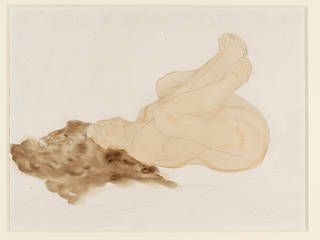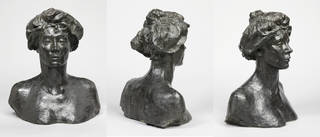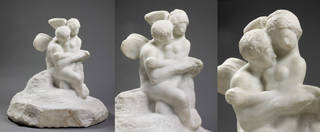Given the spontaneous, naturalistic appearance of Auguste Rodin's (1840 – 1917) sculptures it's easy to forget that each one is the product of many hours of work involving tools, moulds and messy raw materials. The artist's idiosyncratic and varied output demanded an expert grasp on many different kinds of techniques – knowledge Rodin had built up during the two decades he spent working well outside the world of academic sculpture.
For a 19th-century artist who went on to produce sculpture, Rodin's early artistic training was an unusual one. With his application to train as a sculptor having been rejected three times by the Ecole des Beaux-Arts in Paris, Rodin had to fall back on the skills he had learned in his three years at technical college. For the next two decades, he worked as a jobbing craftsman in a range of studios – including those of cabinet-makers, decorators, goldsmiths, fine artists and plasterers – while continuing to develop his own practice. The most influential of these stints was the years Rodin spent with Albert-Ernest Carrier-Belleuse (1864 – 70). A prolific French sculptor working in everything from Sèvres porcelain to marble, Carrier-Belleuse was a gifted pragmatist who had mastered a huge range of technical processes. Time in his highly organised workshop allowed Rodin to perfect his skills, both in modelling clay, and carving stone and marble.

Once he had established himself as an independent sculptor in his late 30s, Rodin set up his own large workshop. In the late-19th and early-20th centuries there was a great demand for both public and domestic sculpture, and Rodin was more than willing to disseminate his work to a wide audience. This commercial ambition relied on the production of multiples – for example, during his lifetime Rodin authorised more than 300 bronze casts of his iconic work The Kiss. Like many other sculptors of this period, Rodin saw the making of sculpture as a collaborative process. He employed highly trained plaster casters, carvers and founders, as well as studio assistants, to turn his free and spontaneous models (worked in clay) into finished works that pushed at the boundaries of sculpture in new and radical ways.

In moving from concept to finished work, the sculptor and his team relied on the following techniques:
Drawing
Drawing was a critical part of Rodin's practice. Rapidly made and keenly observed, his life drawings of models often represented the first stage of making a sculpture. His preferred practice was to record all of a model's different profiles, and to observe the body from different heights – sometimes aided by a stepladder.

Initially, Rodin dictated certain poses to his models but later in his career he preferred them to adopt their own. He particularly liked the unpremeditated poses struck by people who weren't practised models. For example, an Italian labourer, César Pignatelli, arrived at the studio to offer his services and with a refreshingly untutored posing style (Pignatelli apparently stood on the platform, planted his legs firmly and opened them up 'like a compass') inspired Rodin to begin work on an unconventional walking sculpture of St John the Baptist.

Clay modelling and plaster casting
Once Rodin had established what he wanted to achieve with a new piece (with or without the help of drawings), he used clay to form a three-dimensional sculpture. A copy was then made of this 'raw' original using a mould, producing either a plaster cast or plaster relief. Rodin often had several casts made of an original, allowing him to create a number of different versions, as well as to cut casts up as a means of working out further possibilities. Over time he built up a huge repertoire of plaster moulds and models, using them to devise new figurative combinations and juxtapositions, or to find fresh solutions to compositional problems. Rodin also had plaster casts made of his finished, carved marbles to allow them to be cast in bronze – the plaster version acting as a surrogate to avoid damage to the surface of the prized original.

Lost-wax casting
Rodin is known to have favoured the lost-wax casting technique (in French, 'cire perdue') to make bronze versions of the 200-plus individual and group pieces he developed between 1880 and 1890 for his seminal project, The Gates of Hell, a vast decorated doorway. One of the few Parisian foundries capable of producing bronze casts using this demanding technique (based on creating a series of moulds) was Montagutelli Frères. Run by two brothers, this firm cast all three of the only lost-wax pieces by Rodin in the V&A's collection: two portraits of the Duchesse de Choiseul (a friend of Rodin's who was a strong influence on both Rodin and his business) and one of Eve Fairfax (a favourite subject of Rodin whose first portrait bust was commissioned from him as a wedding present).

Sand casting
Most of Rodin's work in bronze is sand cast, which during the artist's time in Paris was still the main method of producing sculptural multiples. In this technique, the original clay model is pressed into sand (mixed with a suitable bonding agent), leaving a negative imprint from which a solid positive cast in metal can be made. This cast is usually hollow, having had a slightly smaller solid core pinned inside it to prevent the molten metal penetrating throughout the mould cavity. Rodin usually worked on his sand-cast bronzes with Alexis Rudier, a skilled founder whom the sculptor trusted to produce true copies of his challenging originals.

Finishing
The traditional 'antique' finish on bronze sculptures is created by applying chemicals onto the surface that produce an artificial patina that mimics the green or brown film that is produced naturally, over time, by oxidisation on the surface of the bronze. Rodin was very focused on the use of this technique in the finishing of his work because the effect of light in creating surface form was very important to him. The sculptor's meticulous focus on patination was demonstrated through technical analysis of a version of The Age of Bronze held in an American collection. The results showed that the surface paint of the bronze was applied in three stages. However, Rodin wasn't a conventional perfectionist as some of his finished bronzes clearly exhibit the seam lines of the casting process – perhaps as a means of acknowledging rather than denying the manufacturing process and source material.

Carving
Many of Rodin's pieces were copies of the artist's originals made from marble, rather than cast in bronze. It's hard to determine how many of these carved pieces are actually Rodin's work. His training would have included carving but in his own workshop it is more likely that he would have simply supervised the work, making pencil or chalk marks to guide highly skilled specialist assistants (which was normal practice at that time). In recreating an exact form in marble, Rodin's assistants would have used a mechanical device based on a pantograph to scale the original clay model up or down in size. The contrast of rough-hewn rock and finished figures in many of his carved pieces indicates the artist's admiration for the work of, among others, Michelangelo.

Assemblage
Later in life, Rodin experimented by making 'assemblages'. In Torso of a Woman, for example, he set a bronze torso on a plaster cast he had taken from a classical marble pedestal in his collection (over time he had accumulated a large number of antique pieces). There are many other instances of Rodin creating unusual juxtapositions, either adding classical work to his own plaster casts to create new sculpture, or forming new combinations using existing plaster casts. The freedom with which he did so demonstrates a departure from normal workshop practice, and an increasingly conceptual approach to the making of work that points to 20th-century developments in sculptural practice.

Find out more about Auguste Rodin.

